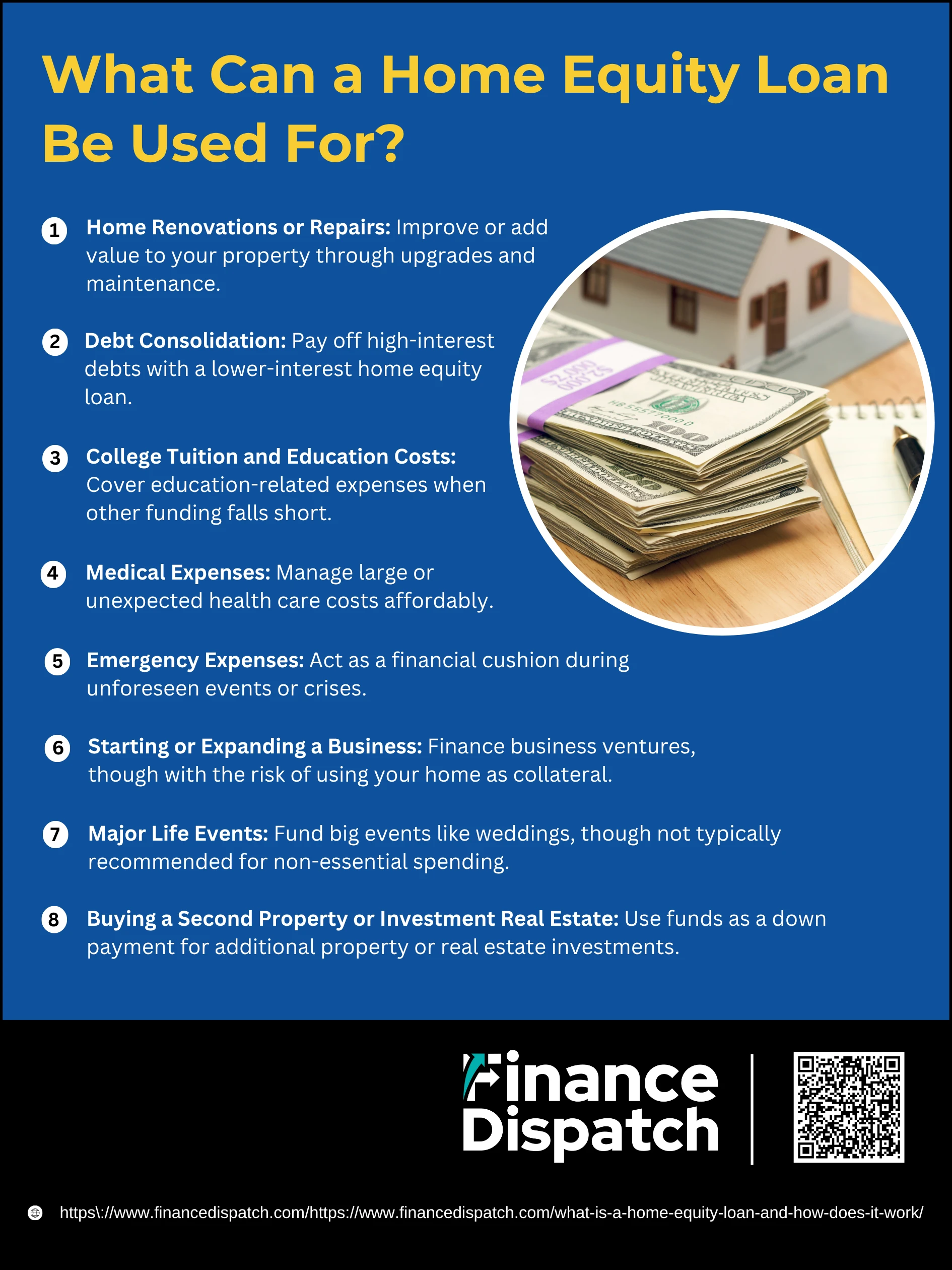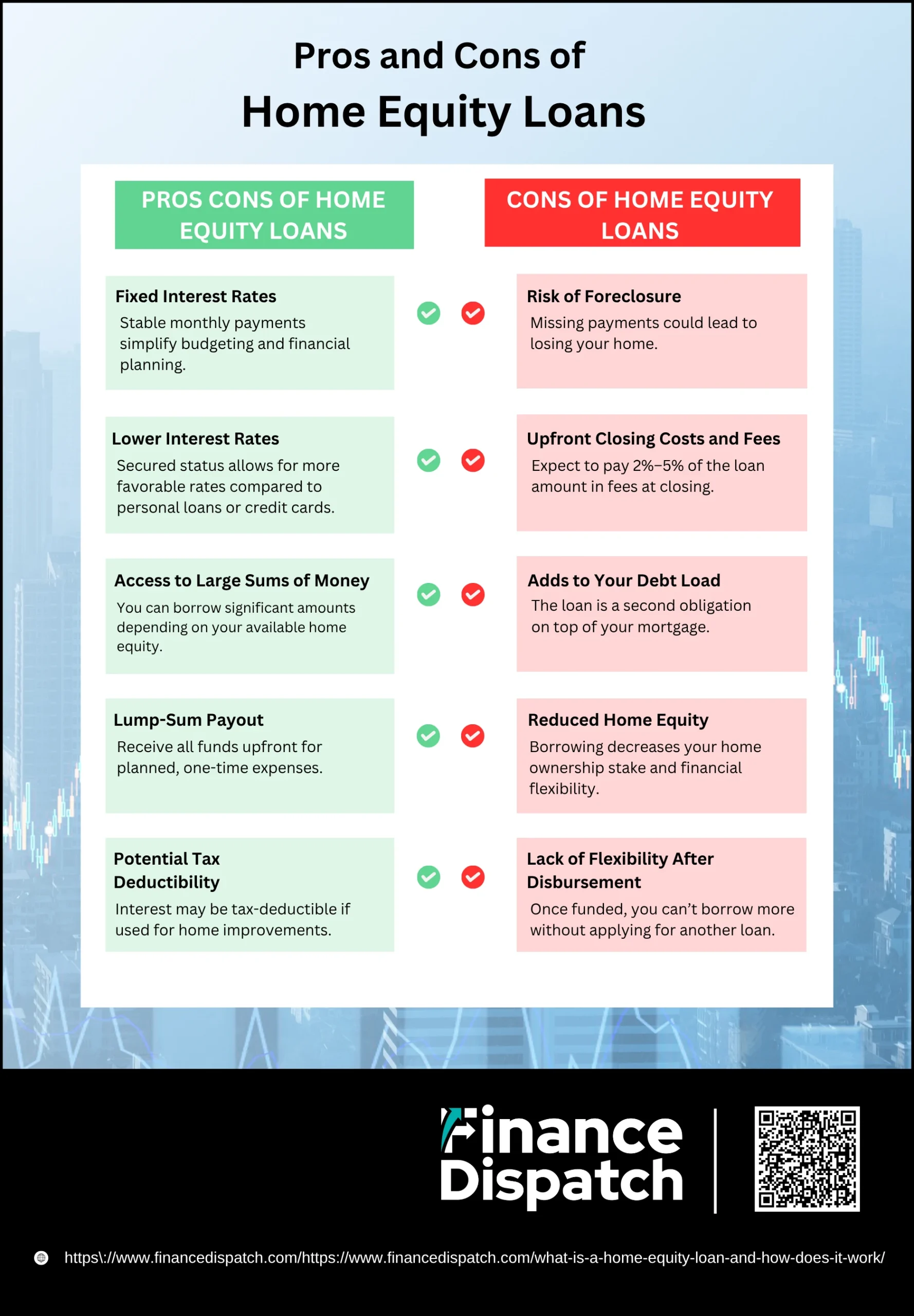A home equity loan is a powerful financial tool that allows you to borrow money by tapping into the value of your home. Often referred to as a second mortgage, it provides a lump sum of cash that’s secured by the equity you’ve built through mortgage payments and rising property value. With fixed interest rates and predictable monthly payments, home equity loans can be ideal for funding large expenses like home renovations, consolidating high-interest debt, or covering major life events. However, because your home is used as collateral, it’s crucial to understand how these loans work—and whether they’re the right fit for your financial goals.
What Is a Home Equity Loan?
A home equity loan is a type of secured loan that lets homeowners borrow against the equity they’ve built up in their property. Equity is the difference between your home’s current market value and the remaining balance on your mortgage. When you take out a home equity loan, you receive a lump sum of money, which is repaid over time with fixed monthly payments and a fixed interest rate. Since the loan is backed by your home, it’s often easier to qualify for and offers lower interest rates than unsecured loans like credit cards or personal loans. However, because your house serves as collateral, failing to repay the loan can result in foreclosure.
 How Does a Home Equity Loan Work?
How Does a Home Equity Loan Work?
A home equity loan gives you the opportunity to convert the value you’ve built up in your home into cash. With fixed rates and structured repayment terms, it provides predictability—but also puts your property at risk if you’re unable to repay. Here’s a more detailed look at how the process unfolds:
1. Calculate Your Home Equity
To begin, you need to determine how much equity you have in your home. Equity is calculated by subtracting the amount you still owe on your mortgage from your home’s current appraised market value.
Example: If your home is valued at $400,000 and you owe $250,000, you have $150,000 in equity. Most lenders will allow you to borrow up to 80%–85% of this equity, depending on your credit profile and debt-to-income ratio.
2. Decide How Much You Need to Borrow
Unlike a credit line, a home equity loan provides a one-time lump sum. That means you need to plan carefully and estimate exactly how much you need. Common uses include home renovations, debt consolidation, tuition, or large emergency expenses. Borrowing too much can increase your financial burden, while borrowing too little could leave you short and in need of another loan.
3. Shop Around for Lenders
Interest rates, fees, and loan terms can vary widely from one lender to another. Take time to compare offers from banks, credit unions, online lenders, and mortgage companies. Look for competitive annual percentage rates (APRs), low closing costs, and flexible repayment options. Some lenders also offer perks for existing customers, so check with your current bank or mortgage provider.
4. Apply for the Loan
Once you’ve chosen a lender, you’ll fill out a formal application. You’ll typically need to submit:
- Proof of income (pay stubs, W-2s, tax returns)
- A list of outstanding debts
- Employment and credit history
- Proof of homeowners insurance
5. Get a Home Appraisal
To determine the true value of your home, your lender will usually require a professional appraisal. This step is important because it confirms how much equity is available and helps the lender calculate the loan-to-value (LTV) ratio. You may be responsible for covering the appraisal fee, which typically ranges from $300 to $600.
6. Close the Loan and Receive Funds
Once your application is approved and the appraisal is complete, you’ll proceed to closing. This involves signing final paperwork and paying any closing costs (which are generally 2%–5% of the loan amount). After closing, the loan funds are disbursed in a lump sum—either by check or direct deposit into your bank account.
7. Start Repayment
Repayment begins shortly after closing, with fixed monthly payments that cover both principal and interest. Since the interest rate is fixed, your payment amount won’t change over time, which makes budgeting easier. Loan terms usually range from 5 to 30 years. It’s crucial to make payments on time—since your home is collateral, missing payments could lead to foreclosure.
Home Equity Loan Requirements
Before you can qualify for a home equity loan, lenders will need to assess your financial situation to ensure you’re capable of repaying the borrowed amount. Because this type of loan uses your home as collateral, meeting certain requirements is essential—not only to secure the loan but also to obtain favorable terms. While eligibility criteria can vary by lender, most will look for a combination of equity, credit health, income stability, and property condition.
Here are the common requirements to qualify for a home equity loan:
1. Sufficient Home Equity
Most lenders require you to have at least 15% to 20% equity in your home, based on its current appraised market value.
2. Good Credit Score
A minimum credit score of 620 is usually needed, though scores of 700 or higher may help you secure better interest rates.
3. Stable Income
You’ll need to show proof of consistent income, usually for the past two or more years, to demonstrate your ability to repay the loan.
4. Low Debt-to-Income (DTI) Ratio
Lenders often require a DTI ratio of 43% or lower, meaning your monthly debt payments should not exceed 43% of your gross monthly income.
5. Appraisal of Property
An official home appraisal is typically required to determine your property’s fair market value and how much equity you can borrow against.
6. Proof of Homeowners Insurance
You’ll need to provide valid homeowners insurance to protect the lender’s investment in the property.
7. Reliable Payment History
A strong record of on-time mortgage or other loan payments helps establish your creditworthiness.
How Much Can You Borrow?
The amount you can borrow with a home equity loan largely depends on the value of your home and how much equity you’ve built. Most lenders allow you to borrow up to 80% to 85% of your home’s appraised value, minus the balance you still owe on your mortgage. For example, if your home is worth $400,000 and you owe $250,000, you may be able to borrow up to $90,000. However, the final loan amount will also be influenced by factors such as your credit score, income, debt-to-income ratio, and the lender’s specific underwriting criteria.
 What Can a Home Equity Loan Be Used For?
What Can a Home Equity Loan Be Used For?
A home equity loan gives you access to a lump sum of money that you can use for a wide range of purposes. Since this type of loan uses your home as collateral, it’s important to make thoughtful decisions about how you spend the funds. Ideally, the loan should be used for expenses that either add value to your home or improve your long-term financial health. Misusing the funds on non-essential purchases can put your home at risk if you’re unable to repay the debt.
Here are some of the most common and financially sound ways to use a home equity loan:
1. Home Renovations or Repairs
Investing in your home’s improvement—such as a kitchen remodel, new windows, bathroom upgrades, or adding a deck—not only enhances your quality of life but can also boost the property’s market value. Many of these upgrades may qualify you for tax-deductible interest if the loan is used for “buying, building, or substantially improving” the home.
2. Debt Consolidation
High-interest debts from credit cards or personal loans can be rolled into a single, lower-interest home equity loan. This strategy can save you money in interest and simplify your monthly bills—just be cautious not to fall back into debt after clearing balances.
3. College Tuition and Education Costs
Education is an investment in your or your child’s future. Some families use home equity loans to cover tuition, books, or room and board when federal student aid or savings fall short. However, it’s worth comparing this option to student loans that may offer more borrower protections.
4. Medical Expenses
Health emergencies or planned procedures that aren’t fully covered by insurance can be financially overwhelming. A home equity loan may offer a lower interest alternative than a medical credit card or payment plan, helping you cover the cost without high financing fees.
5. Emergency Expenses
In situations like job loss, natural disasters, or sudden income drops, a home equity loan can act as a financial safety net. However, it’s important to use this option only when absolutely necessary and if you’re confident you can manage the repayment.
6. Starting or Expanding a Business
Some homeowners tap into their home equity to fund a new business or grow an existing one. While this can be a way to avoid high-interest business loans, it also carries risk—if the business fails, your home could be in jeopardy.
7. Major Life Events
Big events like weddings, milestone birthdays, or anniversaries can be costly. While it’s possible to use a home equity loan for such celebrations, financial advisors generally caution against taking on long-term debt for short-term occasions unless it’s part of a carefully managed financial plan.
8. Buying a Second Property or Investment Real Estate
You can use the funds from a home equity loan as a down payment on a second home, vacation property, or rental unit. This can be a strategic move if you’re looking to build wealth through real estate, but you should factor in additional property taxes, maintenance, and loan repayment costs.
 Pros and Cons of Home Equity Loans
Pros and Cons of Home Equity Loans
A home equity loan can be an appealing financing option for homeowners who need access to a large amount of cash—especially for planned, high-cost expenses. It offers the advantage of lower interest rates and fixed monthly payments. However, it also comes with serious risks, including the possibility of foreclosure if you default. Understanding both the benefits and drawbacks can help you decide whether this loan type aligns with your financial goals and risk tolerance.
Here’s a detailed breakdown of the major pros and cons:
Pros
1. Fixed Interest Rates
Home equity loans usually come with fixed interest rates, which means the rate you agree to at closing won’t change over the life of the loan. This provides predictable, stable monthly payments—making it easier to plan your budget and manage long-term debt.
2. Lower Interest Rates Than Unsecured Loans
Since home equity loans are secured by your property, lenders see them as lower risk compared to unsecured loans. As a result, you’ll often get a significantly lower interest rate than what you’d pay with a personal loan or a credit card.
3. Access to Large Sums of Money
If you have substantial equity in your home, you may qualify for a large loan amount—typically up to 80% or even 85% of your home’s value minus your current mortgage balance. This makes it ideal for covering major costs like remodeling, medical bills, or consolidating high-interest debt.
4. Lump-Sum Payout
Home equity loans provide all the funds upfront in a single lump sum. This is perfect if you know exactly how much money you need at the start—for example, a full home renovation, large medical procedure, or paying college tuition.
5. Potential Tax Deductibility
If the loan is used for qualifying home improvements (such as building an addition or upgrading a kitchen), the interest paid may be tax-deductible under current IRS guidelines. However, this deduction does not apply if the funds are used for personal expenses or debt consolidation. Always check with a tax professional before assuming eligibility.
Cons
1. Risk of Foreclosure
The biggest drawback of a home equity loan is that your home serves as collateral. If you fall behind on payments, your lender could initiate foreclosure proceedings. This makes it extremely important to borrow only what you can comfortably repay.
2. Upfront Closing Costs and Fees
Like your original mortgage, a home equity loan typically comes with closing costs. These may include appraisal fees, title insurance, origination fees, and more—usually totaling 2% to 5% of the loan amount. These costs can eat into your funds and reduce the overall value of the loan.
3. Adds to Your Debt Load
A home equity loan doesn’t replace your current mortgage—it adds a second debt that you’ll need to repay in addition to your original loan. For some homeowners, this added obligation can strain their finances, especially if their income decreases or expenses rise unexpectedly.
4. Reduced Home Equity
By borrowing against your home’s equity, you’re essentially converting ownership into debt. This can be risky if home values fall, potentially leaving you “underwater” (owing more than your home is worth) and limiting your ability to refinance or sell.
5. Lack of Flexibility After Disbursement
Once you receive the lump sum from a home equity loan, that’s it—you can’t go back and borrow more without applying for another loan. This lack of flexibility can be limiting if your expenses turn out to be higher than anticipated. In such cases, a HELOC may be a better alternative, offering a revolving credit line.
Home Equity Loan vs. HELOC
Both home equity loans and home equity lines of credit (HELOCs) allow homeowners to tap into the equity they’ve built in their property, but they operate in different ways and suit different financial needs. A home equity loan provides a lump sum with fixed interest and predictable monthly payments, making it ideal for large, one-time expenses. A HELOC, on the other hand, functions like a credit card—offering flexibility with a revolving credit line and variable interest rates. Understanding the distinctions between the two can help you choose the option that best aligns with your financial goals.
Here’s a side-by-side comparison:
| Feature | Home Equity Loan | HELOC (Home Equity Line of Credit) |
| Loan Type | Lump-sum installment loan | Revolving line of credit |
| Disbursement | Full amount received at once | Borrow as needed during draw period |
| Interest Rate | Fixed | Variable (some lenders offer fixed options) |
| Monthly Payments | Fixed amount (principal + interest) | Vary based on balance and interest rate |
| Draw Period | Not applicable | Typically 5–10 years |
| Repayment Period | Begins immediately after disbursement | Begins after draw period ends (10–20 years total) |
| Best For | One-time large expenses (e.g., renovations, tuition) | Ongoing or unpredictable expenses (e.g., phased projects) |
| Tax Deductibility | Possible if used for home improvements | Possible if used for home improvements |
| Flexibility | Low – fixed amount | High – borrow, repay, and borrow again |
| Risk of Overspending | Low | Higher due to credit-line accessibility |
Risks and Pitfalls to Avoid in Home Equity Loan
While a home equity loan can be a useful financial tool, it comes with significant risks if not used wisely. Because your home is used as collateral, poor planning or overborrowing can put your property—and your financial future—in jeopardy. Understanding the common mistakes borrowers make can help you avoid the traps that lead to mounting debt or even foreclosure.
Here are key risks and pitfalls to watch out for:
1. Overborrowing Against Equity
Taking out more than you truly need can leave you with unnecessary debt and reduced financial flexibility. If home values drop, you could end up owing more than your home is worth.
2. Using Funds for Non-Essential Expenses
Borrowing for vacations, luxury purchases, or short-lived indulgences doesn’t increase your home’s value and may lead to regret when the repayment bills arrive.
3. Falling Into the “Reloading” Cycle
This occurs when borrowers repeatedly take out new loans to pay off old debts, leading to a dangerous cycle of increasing liabilities without actually reducing total debt.
4. Ignoring the Risk of Foreclosure
Missing payments on a home equity loan can lead to foreclosure, even if your original mortgage is in good standing. This is a serious consequence that borrowers sometimes underestimate.
5. Underestimating Closing Costs and Fees
Many borrowers overlook the additional costs involved in securing a home equity loan—such as appraisal fees, title charges, and origination fees—which can reduce the net benefit of the loan.
6. Relying on Unrealistic Home Appraisals
If your home is appraised at an inflated value, you might borrow more than your house can support in a down market, putting yourself at risk of negative equity.
7. Borrowing Without a Repayment Plan
Taking a loan without a clear, realistic plan for repaying it—especially if your income fluctuates—can lead to missed payments and long-term financial strain.
8. Not Comparing Lenders
Accepting the first offer you receive may result in higher interest rates or unfavorable terms. Shopping around can help you secure a better deal.
Alternatives to Home Equity Loans
While a home equity loan can be a smart way to access cash for large expenses, it’s not the only option—and it may not always be the best one. If you’re hesitant about using your home as collateral or prefer more flexible borrowing terms, several alternatives are worth considering. These options vary in terms of interest rates, repayment structures, and qualification criteria, so it’s important to evaluate them based on your financial goals and risk tolerance.
Here are some popular alternatives to home equity loans:
1. Home Equity Line of Credit (HELOC)
A revolving credit line secured by your home equity, HELOCs offer flexibility to borrow as needed over time, typically with variable interest rates.
2. Cash-Out Refinance
Replaces your existing mortgage with a new, larger one and gives you the difference in cash. This is ideal if current mortgage rates are lower than what you’re currently paying.
3. Personal Loan
An unsecured loan with fixed payments and no risk to your home, though it usually comes with higher interest rates compared to secured loans.
4. Credit Cards with 0% Intro APR
For smaller expenses or short-term borrowing, a credit card offering 0% interest for a limited time can be a cost-effective solution—if paid off before the intro period ends.
5. Personal Line of Credit
Offers flexible access to funds up to a certain limit, with interest paid only on the amount borrowed. Unlike a HELOC, this type isn’t secured by your home.
6. 401(k) Loan
Allows you to borrow from your retirement savings. While there’s no credit check and interest is paid back into your account, it reduces your retirement growth and could trigger penalties if not repaid on time.
7. Reverse Mortgage (for seniors 62+)
Lets older homeowners convert part of their home equity into cash without monthly repayments. The loan is repaid when the home is sold, but fees and risks must be carefully reviewed.
Tips to Get the Best Home Equity Loan Rates
Securing a low interest rate on your home equity loan can save you thousands of dollars over the life of the loan. Lenders determine your rate based on several factors—including your credit score, income, debt levels, and the value of your home. By preparing in advance and making smart financial moves, you can improve your chances of qualifying for a more favorable rate.
Here are some practical tips to help you get the best home equity loan rates:
1. Improve Your Credit Score
A higher credit score signals lower risk to lenders. Pay down existing debt, make all payments on time, and correct any errors on your credit report to boost your score.
2. Lower Your Debt-to-Income (DTI) Ratio
Try to reduce your monthly debt payments in relation to your income. Paying off credit cards or other loans can help you qualify for better terms.
3. Shop Around and Compare Offers
Don’t settle for the first offer you receive. Compare quotes from banks, credit unions, and online lenders to find the best rate and lowest fees.
4. Opt for a Shorter Loan Term (If Affordable)
Shorter loan terms usually come with lower interest rates. If you can afford higher monthly payments, this option can save you money over time.
5. Maintain Steady Employment and Income
Lenders favor borrowers with stable job histories and consistent income, as it reflects your ability to repay the loan.
6. Choose a Lender You Already Work With
Some financial institutions offer discounts or preferential rates to existing customers, especially those with checking or savings accounts.
7. Avoid Borrowing the Maximum Amount
Borrowing less than the full amount you’re eligible for may improve your rate offer, as it reduces the lender’s risk.
8. Pay Attention to Closing Costs and APR
A low interest rate doesn’t always mean a cheap loan. Review the Annual Percentage Rate (APR), which includes fees and gives a more accurate picture of your total loan cost.
Is a Home Equity Loan Right for You?
Deciding whether a home equity loan is right for you depends on your financial goals, stability, and the purpose of the loan. If you have built up substantial equity in your home, have a steady income, and need a large lump sum for a specific expense—like a major renovation, medical bill, or debt consolidation—a home equity loan can offer lower interest rates and predictable payments. However, it also comes with risk, as your home is used as collateral. If you’re unsure about your ability to repay or are considering using the funds for non-essential spending, it may be wise to explore other financing options. Carefully evaluating your needs, budget, and long-term plans is essential before committing to this type of loan.
Conclusion
A home equity loan can be a powerful financial tool when used wisely, offering access to a lump sum of cash with fixed interest rates and stable monthly payments. It’s particularly beneficial for homeowners who need to fund large expenses like home improvements, debt consolidation, or education costs. However, since your home serves as collateral, it’s essential to approach this type of borrowing with caution. Misusing the funds or falling behind on payments could put your home—and your financial future—at risk. By understanding how home equity loans work, comparing them to alternatives, and evaluating your personal financial situation, you can make a confident, informed decision that supports your long-term goals.



